Today, metal-plastic windows are a popular product among all users. Almost every apartment in the building has PVC windows installed in at least one room. But during operation, various problems may arise. For example, windows can jam, Maybe do not turn the handle or there may be other problems with opening and closing windows. In order to solve the problem, you need to know how to adjust plastic windows.
It is worth noting that PVC windows stop functioning correctly not only due to a long period of operation. And given the average service life of windows (more than 15 years), it is unlikely that owners of such double-glazed windows should have any difficulties. However, problems do happen, quite often. And if you can’t call a specialist or don’t want to spend extra money on repairs, you can make basic adjustments to the plastic window yourself, which will help get rid of most problems.
When and for what problems is adjustment necessary?
Of course, you need to adjust PVC windows yourself as needed. As soon as a certain problem arises, you should immediately look for ways to eliminate it. Even with correct initial “calibration,” problems may arise later. They are associated with improper operating techniques, deformation of fasteners, violations of structural integrity, tightness, etc.
What problems can be eliminated using self-adjustment of PVC windows?
Advice: If you cannot independently and accurately determine the cause, you need to seek help from a specialist. Still, it is better to pay for minor repairs than to replace broken parts of a metal-plastic structure.
Tools required for adjustment
In order for plastic windows to be adjusted independently, you will need a few tools. Configuration is carried out using:
- A set of hexagons (a 4 mm hexagon must be included in the kit);
- Cross-shaped and star-shaped screwdriver bits (as a rule, they should be marked “T” or “TX”);
- Phillips screwdriver size 3 or 4;
- Pliers;
- Universal WD-40 aerosol and regular machine oil.
Mainly used only hexagon, which in everyday life is called a furniture key. This is a small L-shaped metal hexagonal rod, which can be made in an S-shape for ease of use.
Star attachments are necessary for working with certain models of fittings, so it is better to take several of these attachments. As a rule, the fittings are fastened by craftsmen with ordinary screws and a Phillips screwdriver, so to adjust them you will need the latter.
The adjustment process is greatly simplified if the operation of the sliding windows is disrupted. In this case, all work comes down to adjusting the roller carriages intended for fastening the sash.
Main adjustment points for PVC windows
There are a total of five adjustment points on the window that help you make the correct settings. Let's take a closer look at each of these points.
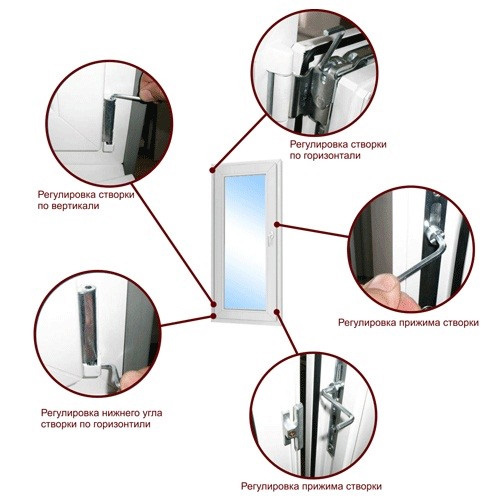
Using all of the above points, you can calibrate all existing window positions. As a rule, all manufacturers produce standard window models, so if your metal-plastic double-glazed windows were not made to order, then there will be no difficulties in determining each adjustment point.
Tip: Immediately after you find these points, check them for deformation - in this case, you will need to immediately contact a specialist. And if debris is found, you need to remove it and try again to carry out the action that was previously performed with difficulty.
General features of adjusting PVC windows
How to properly adjust plastic windows and how to do it yourself? It must be remembered that there are different window models. They provide different fittings, double-glazed windows and strength. We tried to summarize all existing options and derive common features that allow you to customize windows.
Horizontal adjustment
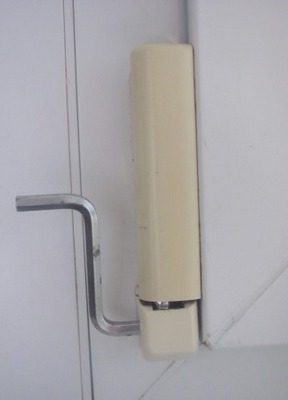
To move the frame or eliminate a slight bevel, it is necessary to use horizontal adjustment, which is carried out using bottom And top loops. The hinges themselves have special hexagon holes. The lower hinge allows adjustment from both the outside and the inside (accordingly, you can adjust the window open or closed). As a result of turning the key clockwise, the sash with the hinge will be tightened. As a result of this action, the bottom of the window, which is on the opposite side of the hinge, will rise. Accordingly, when rotating counterclockwise, the lower part of the window will lower.
Horizontal adjustment of plastic windows can also be carried out independently in the area of the top hinge, as a result of which the top of the sash will already be adjusted, but this must be done only with the window open. It should be noted that the shift is within 2 mm.
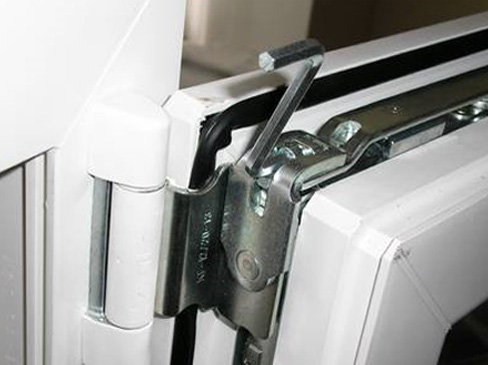
Vertical adjustment
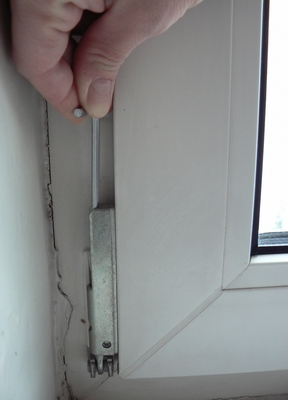
Metal-plastic windows can be calibrated vertically using bottom hanging loop. To do this, you must open the plug to ensure free access to the hexagon. The sash will begin to rise when the hexagon is rotated clockwise, and in the opposite direction the sash will begin to fall. As with the horizontal adjustment, the shift range is 2 mm.
Adjusting the sash pressure
It is used when there is blowing from a PVC window. The quality of the pressure can be checked as follows: a lit match is brought to a closed PVC window and the movement of the flame is observed. If it deviates to the side, then there is a gap in the window.
In this case, the pressure is adjusted using eccentrics, which are located along perimeter of fittings(this method is used to adjust plastic windows for the winter). As a result of turning the handle, they move beyond the pressure pads. Since the setup is not particularly difficult, you can also do it yourself.
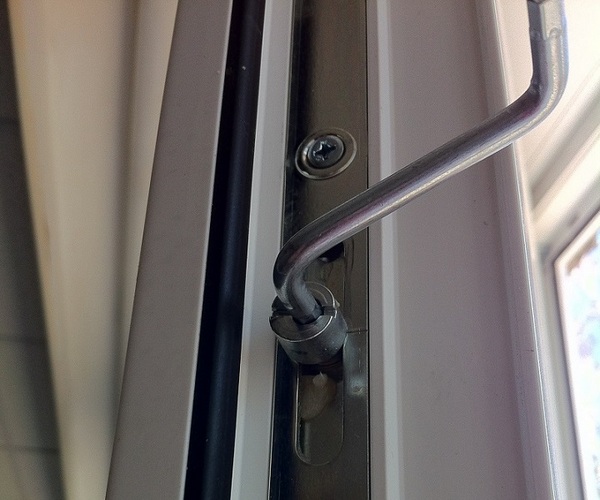 The sash pressure is adjusted using eccentrics (trunnions)
The sash pressure is adjusted using eccentrics (trunnions) The sash will be pressed against the frame if the eccentric is moved clockwise. Accordingly, when the eccentric is moved counterclockwise, the sash will move away from the frame. There is a small strip on the surface of the eccentric, with which you can determine the degree of compression of the sash and frame. The closer this strip is to the seal, the stronger the sash is pressed.
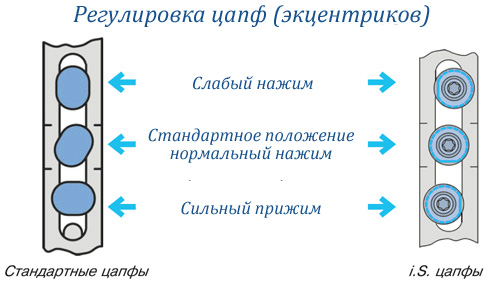
The adjustment range is within 1-2 mm. More or less strong pressure on the sash is allowed at different times of the year - In summer you can loosen it, and in winter you can tighten it more. This is done to ensure air supply - more air will flow in the summer, and less in the winter.
Tip: Do not clamp the sash and frame too tightly. This can lead to premature wear of the seal.
Adjusting the hinges
The tilt window has two hinges that can be adjusted to improve functionality. The lower hinges are adjusted using a horizontal screw located on them. In order to adjust the pressure of the upper hinges, you need to open the PVC window for ventilation (turn the handle so that only the upper part of the window opens). In this case, you need to hold the window with your hand, since it will only be held on one, lower hinge. Adjusting the hinges helps determine the degree of compression of the window with hinges. The acceptable range is within 2.5 mm. As the distance increases, the window will adhere less to the hinges and more air will be provided. As the distance decreases, the window will fit more tightly to the hinges and provide reliable protection from air coming from outside.
Conclusion
The following conclusion can be drawn: the adjustment of all positions of the adjustment points can be carried out even without experience. The only requirement is to be careful. Incorrect calibration may cause the window to no longer function correctly. As a result, you will have to call a technician to re-set it up.
Adjusting plastic windows video
In this section, we invite you to watch a video on the topic of our article on how to adjust plastic windows.
Still have questions? Ask them in the comments!